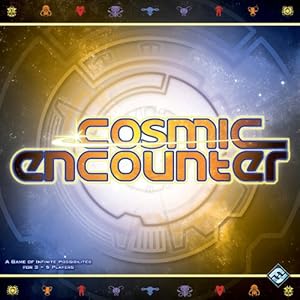In my hometown of Charlotte NC, there is a Meetup Group dedicated to strategy boardgames. A group of 20 or so will gather in a local restaurant and play games for a few hours. Typically 3-4 games are going at one time so there is always something of interest for everyone in attendance. At this particular meeting, Cosmic Encounters was one of the featured games and this was a game I've been wanting to try for awhile because it is very popular, well rated and the #1 game on The Dice Tower's Top 100 game list - 2011 Edition.
Cosmic Encounter is an old game compared to most popular strategy games out today. It was released in 1977 then picked up Fantasy Flight Games and re-released in 2008. At it's core, it's a Sci-Fi themed game where you represent an alien race whose goal it is to conquer planets. Three to five players (six with an expansion) get 5 planets and 20 ships to place on their planets (4 per planet). Each player gets a hand of cards that have numbers on then, or an 'N' (Negotiate cards) or artifact cards (which I'll cover later). During a players turn, the player will flip over a card in a separate deck that has a color on it. The color represents the player that is to be attacked. The attacking player takes up to 4 of his/her ships and moves them in front of one of the defenders planets. Now the attacking player can ask specific players if they want to help the attack. The defender can then ask players if they want to help to defend. One at a time, the players who were asked to help can dedicate up to four of their ships. If they were asked by both players to help, they must make a decision who to help or not help at all. Once all ally ships have been put into place for the attacker and defender, the attacking and defending players will then play a card from their hand face down on the table. At the same time, both cards are flipped over. The numbers on the card are added to the ships in the battle. If the attacker exceeds the defenders value then it inhabits a planet by placing a ship on it. The allies that joined the attacker also get to place a ship on the planet and inhabit it. If the defender wins, he keeps the planet and the allies that help defend get to draw cards equal to the number of ships they committed to defend. The losers in the battle must move their ships to a zone in the middle of the table. Those ships can no longer be used but at the beginning of a players turn, one ship can be reclaimed from the zone. If one of the players plays a Negotiate card, that means they are basically conceding the battle (waving the white flag). But if they do so, they get to randomly take 4 cards from the other players hand. If both players play Negotiate cards, it's a draw and they have a minute to negotiate an agreement such as trade cards, or agree to allow the other player occupy one of their planets. If no agreement is made, then each player loses three ships. The goal of the game? Be first player to inhabit 5 planets..
That's the rules in a nutshell. But like any good game, there is some mechanic to 'break' the basic rules. That is done by the alien race you play as. At the beginning of the game, each player gets two random alien race cards. The player picks one to be for the game. Each race has certain abilities such as The Pacifist, if they play a Negotiate card they automatically win the battle (unless the other player plays a Negotiate card then the standard rules apply). The Oracle, while in battle, the other player must play their card face up so you can see what it is. Other aliens earn special rewards if you win, keep allies from losing their ships. etc. Their are 50 alien races overall and even more in expansions. Another way to break rules is with the artifact cards which can be used during games to nullify a aliens ability, or nullify a card someone else plays.
So while the game is simple, the fun of the game comes in the player interaction. There is constant talk of who is going to help who. As one player takes a lead, others come to the aid of the defender to keep the leader from taking another planet. Or sometimes asking others to help defend could be bad because you don't want them to have any more cards. Or the attacker taking allies means giving other players planets. As a result, there is no player downtime. Every player can be involved in every turn.
The game can take 1-2 hours depending on how cutthroat the game becomes. But so much is going on, you don't even realize how much time has passed.
Another member of my smaller gaming group also played that night and we both agreed that for our group, this game could be a lot of fun. With so many alien races, each game will be different, thus the strategy will be different. I can see how The Dice Tower ranks this game so high year after year and I look forward to playing again.

No comments:
Post a Comment